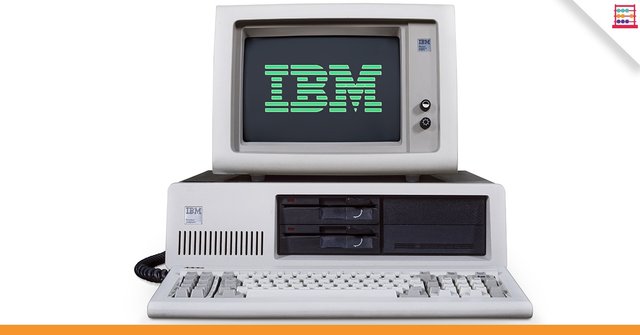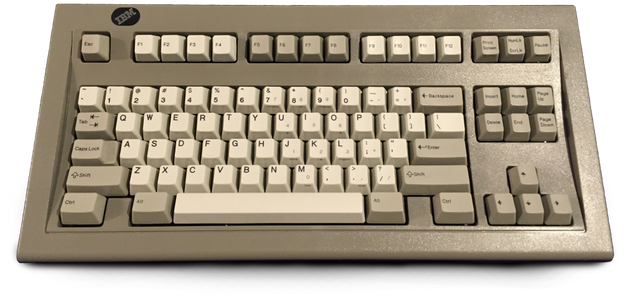The Dairy Game 24/08/2021 - 5150 Model The First IBM PC

A few days ago it was 40 years since IBM launched the first PC, the 5150 model, the one that would change the world and direct it in the direction that PCs still have today: open architecture, freely available components, expansion slots that can be populated with various boards and so on.
Computers up to 1981 were large and expensive units, accessible only to corporations. "Office" or "home" units were few, but the future looked good. On the market were models such as Apple II, Commodore PET and Tandy TRS-80, and in total the market since 1979 was 15 billion dollars.
The problem at the time was that the design of a PC took a long time and the architectures were closed, with custom-made components by each manufacturer. IBM saw a great growth opportunity in the future and gave a free hand to an engineer named Bill Lowe to create a PC accessible to all. At the time, an IBM microcomputer cost at least $ 20,000 and was therefore not suitable for home or small business.
Lowe decided to use standard hardware and software, available on IT store shelves, which would have meant that future customers would be able to upgrade and repair these PCs in a more convenient way than "send it back to IBM." The move was bold, given that IBM produced its own components and software and would have made a lot more money per unit if it included them, but the problem turned into “okay, but how many PCs would be sold with this strategy? ”
Lowe quickly made a prototype. The story says it worked poorly, but managers were convinced by his estimates of sales of 220,000 pieces in the next 3 years. The estimate was to be exceeded by 800% in the end.
Lowe has created a team to secretly work on this project at a Florida headquarters. It lasted a year. This was very unusual for IBM, which had much slower procedures, but Lowe's team ("Project Chess") had special character and powers. This kind of strategy is also followed in other areas, as far as I know the BMW i3 was designed in a similar way.
150 engineers worked on IBM's first Personal Computer, called the Model 5150. It debuted on August 12, 1981 at a price of $ 1,650 for the 16 kB version of RAM. Yes, I said 16 kilobytes, not even 1 megabyte. There is also a higher version with 64 KB RAM.
As hardware, the processor was an Intel 8088. See the strategy above: IBM designed its own processors, which were more powerful, but wanted off-the-shelf components. Intel 8088 was a weaker version of 8086 (with 8-bit external bus instead of 16-bit), 8086 being the processor that opened the series with which Intel was to dominate the PC market for many years, being successfully continued by 286, 386 and so on.
8088 was therefore weaker, but cheaper. It runs at 4.77 MHz. A mathematical coprocessor could be added to the motherboard, for those who needed it (Intel code 8087), another good sign of open architecture.
16 or 64 KB RAM, but upgradable to 256 KB by adding new boards available in stores. Storage was done only on 5.25 ″ diskettes. The power supply for the first IBM PC could not support a hard drive, but later versions or external HDDs with a built-in source corrected this.
The monitors were usually 80 x 25 monochrome, meaning they could display 80 text characters horizontally and 25 lines of text vertically. There were times when it was not about resolution as it is now, but about columns and strings, no matter what they were. PC versions with better graphics were also launched, if you used a PC graphics card. The various expansion slots, by the way, were the basis of the ISA (Industry Standard Architecture) standard, which over time was replaced by PCI and then PCI-Express.
The keyboard was, of course, large and noisy.

The included software was PC-DOS, which Microsoft produced for IBM, released with the Model 5150. DOS = disk operating system. Microsoft produced it as MS-DOS, but IBM licensed it under the name PC-DOS and with changes large enough to run on their hardware, which in fact makes Microsoft make a substantial contribution to this through personal computer at IBM.
I think that in 1981, when there were no hard drives in the Model 5150, the operating system was loaded from the 5.25 ″ floppy disk at boot and passed into the computer's RAM. Then you could take out that floppy disk and insert another, maybe one with a spreadsheet program like Lotus or a WordPerfect or an Autocad, I don't know. I think that's how it all worked.
However, PC-DOS took out of the business another operating system that was popular until then called CP / M. The success of IBM PCs also meant the rise of Intel and the decline of Motorola, NEC, Texas Instruments and other processor manufacturers. That makes a disruptor.
Drawing the line, IBM then created a PC that was best-bought by its advantages. People bought a PC for their home and then equipped it in expansion slots with sound cards, mice, telephone modems or other controllers for various components, as needed. Hundreds of thousands of pieces were sold annually, far exceeding forecasts.
Apple is currently the largest technology company by revenue and the most valuable company in the world on the stock exchange. He is part of the American Big 5 in technology, along with Amazon, Facebook, Google and Microsoft.
IBM is celebrating its 110th anniversary this year. He amassed a record number of patents and invented ATMs, barcodes, floppy disks, hard disks and was one of the big players in PCs, laptops and servers. It is currently undergoing a massive reorganization, separating many businesses into a stand-alone company (Kyndryl) for IBM to focus on hybrid cloud and AI.

Image Sources:
Non sapevo che fossero passati 40 anni dal primo PC dell’IBM!!! IO ne ho 47, il PC è più giovane di me